List of Organs of the Human Body ❤️ Functions and Pictures
Sortable list of the largest organs of the human body. Includes location of organs inside the body, what they look like and their function. We’ve included a few human body parts which are not human organs (greyed out) to make size comparison easier. We have considered including interstitium (connective tissue) which weighs around 20% of our body weight but it’s not currently widely classified as a human organ.
- ADDucation’s list of 78 organs of the human body was compiled by Joe Connor and last updated 20 Mar 2022.
ADDucation Tips: Click column headings with arrows to sort all organs of the human body. Reload page for original sort order. Resize your browser to full screen and/or zoom out to display as many columns as possible. Click the ➕ icon to reveal any hidden columns. Start typing in the Filter table box to find anything inside the table of all organs of the human body
Human OrganAverage weight in kgAverage weight in lbsLocationProperties and fun factsFunctions and tasksMuscles 3577Around the bodyThere are around 700 named muscles in the human body and hundreds of other unarmed muscles which weigh between 30-40 kg (66-88 pounds). There are three types of muscle tissue skeletal, cardiac and smooth.
3577Around the bodyThere are around 700 named muscles in the human body and hundreds of other unarmed muscles which weigh between 30-40 kg (66-88 pounds). There are three types of muscle tissue skeletal, cardiac and smooth.
- Involuntary muscles work our internal organs and are beyond our control
- Voluntary muscles are attached to the skeleton and can be controlled to make the body move.
Skin / Derma 4.5 / 159.9 / 33Over the skeleton around the bodySkin is made up of three layers; the outermost epidermis layer, the Dermis and the subcutaneous tissue. The first figure is the weight of the skin followed by the total weight which includes the subcutaneous tissue and fat deposits. At up to 1.95 square meters (21 sq ft) the skin is the largest of all organs of the human body weighing between 6-10% of body weight. Oil glands stop skin drying out. Skin cells are continuously shedded and replaced. Skin is a versatile organ with an ideal pH value of 5.5.Responds to external stimuli (touch, heat) and uses sweat to cool the body and raised hairs (goosebumps) to trap heat and warm the body regulating the overall temperature. Protects us from UV radiation and injury by producing thick skin (calluses).Intestines
4.5 / 159.9 / 33Over the skeleton around the bodySkin is made up of three layers; the outermost epidermis layer, the Dermis and the subcutaneous tissue. The first figure is the weight of the skin followed by the total weight which includes the subcutaneous tissue and fat deposits. At up to 1.95 square meters (21 sq ft) the skin is the largest of all organs of the human body weighing between 6-10% of body weight. Oil glands stop skin drying out. Skin cells are continuously shedded and replaced. Skin is a versatile organ with an ideal pH value of 5.5.Responds to external stimuli (touch, heat) and uses sweat to cool the body and raised hairs (goosebumps) to trap heat and warm the body regulating the overall temperature. Protects us from UV radiation and injury by producing thick skin (calluses).Intestines 2.04.4Abdominal body cavityThe small and large intestines are about 8 metres (26¼ feet) long and weigh around 2 kg (4½ pounds). The small intestine includes the duodenum, jejunum and ileum. The large intestine (also known as the large bowel) includes the cecum, colon, rectum and anal canal. The large intestine processes around 45 tonnes (50 US tons) of food in an average lifetime. It’s possible to survive without intestines.
2.04.4Abdominal body cavityThe small and large intestines are about 8 metres (26¼ feet) long and weigh around 2 kg (4½ pounds). The small intestine includes the duodenum, jejunum and ileum. The large intestine (also known as the large bowel) includes the cecum, colon, rectum and anal canal. The large intestine processes around 45 tonnes (50 US tons) of food in an average lifetime. It’s possible to survive without intestines.
- Digestion and absorption of food (protein, carbohydrates, salts, vitamins and fats)
- Extracts fluids from food pulp
- Excretion of stools.
Liver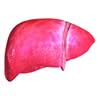 1.43.1Upper right abdominal cavity just beneath the diaphragmThe liver (“Iecur” or “hepar”) is the largest gland in the body with soft smooth surface, left and right lobes and weighs between 1.4-2 kg (3-4.4 lbs). The tissue consists of around 100,000 lobules and is metabolically the most complex human internal organ. The liver is one of the vital organs of the human body.Stores energy reserves (vitamins and carbohydrates), detoxifies and breaks down nutrients, produces vital proteins (clotting factors).Brain
1.43.1Upper right abdominal cavity just beneath the diaphragmThe liver (“Iecur” or “hepar”) is the largest gland in the body with soft smooth surface, left and right lobes and weighs between 1.4-2 kg (3-4.4 lbs). The tissue consists of around 100,000 lobules and is metabolically the most complex human internal organ. The liver is one of the vital organs of the human body.Stores energy reserves (vitamins and carbohydrates), detoxifies and breaks down nutrients, produces vital proteins (clotting factors).Brain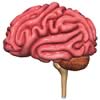 1.32.9Inside the skullThe female “cerebrum” weighs around 1.2 kg (2.8 lbs) compared to 1.4 kg (3 lbs) for males. The brain consumes between 20-25% of our total energy intake. The brain consists of 100 billion neurons (somata) and 100 trillion synapses. The neural pathways are 5.8 km (3.6 miles) long in total. The brain is one of the vital organs of the human body.Processes sensory inputs, coordinates behavior and saves information; cerebrum (perception, thinking, acting), diencephalon (feelings like love, fear, anger etc.), cerebellum (balance while walking, running, dancing etc).Lungs
1.32.9Inside the skullThe female “cerebrum” weighs around 1.2 kg (2.8 lbs) compared to 1.4 kg (3 lbs) for males. The brain consumes between 20-25% of our total energy intake. The brain consists of 100 billion neurons (somata) and 100 trillion synapses. The neural pathways are 5.8 km (3.6 miles) long in total. The brain is one of the vital organs of the human body.Processes sensory inputs, coordinates behavior and saves information; cerebrum (perception, thinking, acting), diencephalon (feelings like love, fear, anger etc.), cerebellum (balance while walking, running, dancing etc).Lungs 1.12.4Inside chest rib cageThe “pulmo” typically weighs just over 1kg (2.2 lbs) and has a volume between 5-6 liters (10.5-12.7 US pints) with 400 million alveoli. The (smaller) left lung consists of two lobes, the right one of three lobes. The lungs are one of the vital organs of the human body.Gas exchange between air and bloodstream. In other words absorption of oxygen and release of carbon dioxide from the body.Stomach
1.12.4Inside chest rib cageThe “pulmo” typically weighs just over 1kg (2.2 lbs) and has a volume between 5-6 liters (10.5-12.7 US pints) with 400 million alveoli. The (smaller) left lung consists of two lobes, the right one of three lobes. The lungs are one of the vital organs of the human body.Gas exchange between air and bloodstream. In other words absorption of oxygen and release of carbon dioxide from the body.Stomach 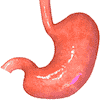 0.912.0Left side of the upper abdomen.The stomach is mostly muscular and can contain up to 4 liters, 7 UK pints or 8.5 US pints of food and drink to digest. The total weight of a full stomach could be as much as 5kg or 11 lbs. The stomach is approximately 30cm long and 15cm wide (12″ x 6″). It’s possible to survive without a stomach.The stomach receives food from via the esophagus and produces acid and enzymes to digest food which slowly turns it into “chyme” which is moved by the stomach muscles into the small intestine.Heart
0.912.0Left side of the upper abdomen.The stomach is mostly muscular and can contain up to 4 liters, 7 UK pints or 8.5 US pints of food and drink to digest. The total weight of a full stomach could be as much as 5kg or 11 lbs. The stomach is approximately 30cm long and 15cm wide (12″ x 6″). It’s possible to survive without a stomach.The stomach receives food from via the esophagus and produces acid and enzymes to digest food which slowly turns it into “chyme” which is moved by the stomach muscles into the small intestine.Heart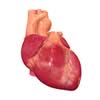 0.3250.71Under rib cage between your left and right lungsThe heart (“cor” or “cardia”) is a fist-sized, hollow, muscular human organ weighing between 300-350g (10-12 oz) with four chambers; the right atrium, right ventricle, left atrium, left ventricle and four valves to stop blood flowing backwards. The heart is part of the cardiovascular system along with blood and blood vessels.Of all organs of the human body the heart is most impressive. At rest it can pump 4.9 liters of blood per minute through our veins. Under duress this can rise to between 20-25 liters of blood per minute.Kidneys
0.3250.71Under rib cage between your left and right lungsThe heart (“cor” or “cardia”) is a fist-sized, hollow, muscular human organ weighing between 300-350g (10-12 oz) with four chambers; the right atrium, right ventricle, left atrium, left ventricle and four valves to stop blood flowing backwards. The heart is part of the cardiovascular system along with blood and blood vessels.Of all organs of the human body the heart is most impressive. At rest it can pump 4.9 liters of blood per minute through our veins. Under duress this can rise to between 20-25 liters of blood per minute.Kidneys 0.30.7Under rib cage in lower backBoth kidneys (“ren” or “nephros”) weigh about 300 g (10½ oz). Between them the 1.2 million renal corpuscles filter up to 1500 liters (400 US gallons) of blood daily. The kidneys are one of the vital organs of the human body but you could donate one kidney and still live a normal life.Purifies the blood and filters out toxins from the body, controls the water balance of the body, excretion of waste products through urine production.Gallbladder
0.30.7Under rib cage in lower backBoth kidneys (“ren” or “nephros”) weigh about 300 g (10½ oz). Between them the 1.2 million renal corpuscles filter up to 1500 liters (400 US gallons) of blood daily. The kidneys are one of the vital organs of the human body but you could donate one kidney and still live a normal life.Purifies the blood and filters out toxins from the body, controls the water balance of the body, excretion of waste products through urine production.Gallbladder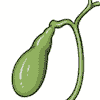 0.30.7below liver near duodenumThe gallbladder “vesica fellea” is a 6-10 cm (2.3-4″) long pear-shaped hollow human organ up to 4 cm (1½”) in length.The gallbladder produces bile, which is needed for (fat) digestion.Diaphragm
0.30.7below liver near duodenumThe gallbladder “vesica fellea” is a 6-10 cm (2.3-4″) long pear-shaped hollow human organ up to 4 cm (1½”) in length.The gallbladder produces bile, which is needed for (fat) digestion.Diaphragm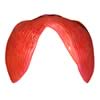 0.210.47Separates chest cavity from abdominal cavity.The diaphragm is the most important respiratory muscle and consists of muscles and tendons. It’s dome-shaped, about 3-5 cm (1¼-2″) thick. One of the smaller but important organs of the human body.The diaphragm pumps 60-80% of the air breathed in into the lungs through contractions of the bronchi (at rest). The contractions cause the chest to rise and fall. A spasm of the diaphragm often causes hiccups.Spleen
0.210.47Separates chest cavity from abdominal cavity.The diaphragm is the most important respiratory muscle and consists of muscles and tendons. It’s dome-shaped, about 3-5 cm (1¼-2″) thick. One of the smaller but important organs of the human body.The diaphragm pumps 60-80% of the air breathed in into the lungs through contractions of the bronchi (at rest). The contractions cause the chest to rise and fall. A spasm of the diaphragm often causes hiccups.Spleen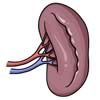 0.170.4Below rib cage on your left sideThe spleen is about the size of a fist and weighs between 150 and 200 grams (5-7 oz). It’s located on the abdomen on the left kidney and below the diaphragm.The spleen produces red and white blood cell pulp helping the immune system fight infections.Pancreas
0.170.4Below rib cage on your left sideThe spleen is about the size of a fist and weighs between 150 and 200 grams (5-7 oz). It’s located on the abdomen on the left kidney and below the diaphragm.The spleen produces red and white blood cell pulp helping the immune system fight infections.Pancreas 0.10.22Behind stomach in abdomenThe pancreas is a wedge shaped organ between 16-20 cm long, 3-4 cm wide and up to 2 cm (3/4″) thick and weighs around 100 grams (3½ oz).The pancreas is a dual function organ which produces enzymes to digest our stomach contents, separating fats, proteins and carbs. The pancreas also regulates blood sugar by producing two hormones, insulin and glucagon which have opposite effects.Tongue
0.10.22Behind stomach in abdomenThe pancreas is a wedge shaped organ between 16-20 cm long, 3-4 cm wide and up to 2 cm (3/4″) thick and weighs around 100 grams (3½ oz).The pancreas is a dual function organ which produces enzymes to digest our stomach contents, separating fats, proteins and carbs. The pancreas also regulates blood sugar by producing two hormones, insulin and glucagon which have opposite effects.Tongue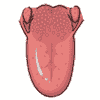 0.0650.14Inside mouth attached to hyoid bone at back of throatThe tongue is a muscular organ, around 10cm (4″) long. The average weight of the male adult tongue is 70g (2½ oz) and 60g (2.1 oz) for females. At any time the tongue contains between 2-8,000 taste buds which only last around 10 days. Although the majority of taste receptors (buds) are on the tongue they are also located on the lips, cheeks and roof of the mouth, up to 10,000 taste buds in total.The tongue is used for speech, manipulating food and sensing tastes. Contrary to popular myth the tongue does not have specialized regions to detect sweet, sour, salty, bitter and umami (found in glutamates).Bladder (urinary)
0.0650.14Inside mouth attached to hyoid bone at back of throatThe tongue is a muscular organ, around 10cm (4″) long. The average weight of the male adult tongue is 70g (2½ oz) and 60g (2.1 oz) for females. At any time the tongue contains between 2-8,000 taste buds which only last around 10 days. Although the majority of taste receptors (buds) are on the tongue they are also located on the lips, cheeks and roof of the mouth, up to 10,000 taste buds in total.The tongue is used for speech, manipulating food and sensing tastes. Contrary to popular myth the tongue does not have specialized regions to detect sweet, sour, salty, bitter and umami (found in glutamates).Bladder (urinary)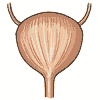 0.0420.092Immediately above and behind the pubic boneThe bladder (“vesica urinaria”) holds up to 550 ml (1.2 US pints) of urine (or with some men even up to 750 ml (1.6 US pints) Ureters connect the kidneys to the bladder and transports the purified blood (urine) to the bladder. The average empty human bladder organ weighs 42g (1½ oz).Stores the urine resulting from the blood purification in the kidneys and removes all toxins (urea, chlorides, sodium, potassium, creatine, bicarbonate, uric acid) from the body through excretion.Thyroid
0.0420.092Immediately above and behind the pubic boneThe bladder (“vesica urinaria”) holds up to 550 ml (1.2 US pints) of urine (or with some men even up to 750 ml (1.6 US pints) Ureters connect the kidneys to the bladder and transports the purified blood (urine) to the bladder. The average empty human bladder organ weighs 42g (1½ oz).Stores the urine resulting from the blood purification in the kidneys and removes all toxins (urea, chlorides, sodium, potassium, creatine, bicarbonate, uric acid) from the body through excretion.Thyroid 0.0350.08Wraps around the front of the windpipe below the Adams apple.The Thyroid gland is one of the largest glands in the body, typically weighing around 35 grams (1.2 oz).Produces thyroxine, triiodothyronine and peptide calcitonin hormones from iodine and tyrosine.Prostate
0.0350.08Wraps around the front of the windpipe below the Adams apple.The Thyroid gland is one of the largest glands in the body, typically weighing around 35 grams (1.2 oz).Produces thyroxine, triiodothyronine and peptide calcitonin hormones from iodine and tyrosine.Prostate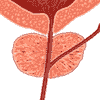 0.020.04Between penis and bladderThe prostate gland typically weighs around 20 grams (¾ oz) and is one of the sex organs of the human body which make up the male reproductive system. Women do not have a prostate gland but instead have Skene glands which are often called the female prostate.Secretes prostate fluid that protects and nourishes sperm and, during ejaculation, the muscles of the prostate gland help propel seminal fluid into the urethra.Skeleton
0.020.04Between penis and bladderThe prostate gland typically weighs around 20 grams (¾ oz) and is one of the sex organs of the human body which make up the male reproductive system. Women do not have a prostate gland but instead have Skene glands which are often called the female prostate.Secretes prostate fluid that protects and nourishes sperm and, during ejaculation, the muscles of the prostate gland help propel seminal fluid into the urethra.Skeleton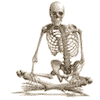 (8.4)(18.5)Under the skinThe “skeletos” in an adult consists of 206-214 bones including 33 vertebrae of the spine. The skeleton accounts for about 12% of body weight. In a 70-kilogram adult, the skeleton weighs about 8.4 kilos. There are also 14-24 separate sesamoid bones embedded within muscles or tendons and 32 teeth. The spine has 24 vertebrae (7 cervical, 12 thoracic, 5 lumbar). Bones consist of 50% water, 15.75% fats, 12.4% cartilage and 21.85% minerals, mostly Calcium.The skeleton carries and supports the entire body structure. Bones aren’t fixed, rigid structures they are alive and adapt to circumstances, heal fractures and renew constantly. Bones grow until around age 25 and typically degrade around 40 years old.Blood
(8.4)(18.5)Under the skinThe “skeletos” in an adult consists of 206-214 bones including 33 vertebrae of the spine. The skeleton accounts for about 12% of body weight. In a 70-kilogram adult, the skeleton weighs about 8.4 kilos. There are also 14-24 separate sesamoid bones embedded within muscles or tendons and 32 teeth. The spine has 24 vertebrae (7 cervical, 12 thoracic, 5 lumbar). Bones consist of 50% water, 15.75% fats, 12.4% cartilage and 21.85% minerals, mostly Calcium.The skeleton carries and supports the entire body structure. Bones aren’t fixed, rigid structures they are alive and adapt to circumstances, heal fractures and renew constantly. Bones grow until around age 25 and typically degrade around 40 years old.Blood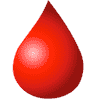 (4.9)(10.8)In blood vessels (arteries, veins, capillaries etc.)Blood (“Sanguis”) makes up around 7% of body weight. For a human weighing 70kg (154 pounds) that’s around 4.9kg (10.8 pounds) which equates to 5 liters (10.6 US liquid pints or 8.8 imperial pints) of blood. Blood consists of 56% plasma, 44% blood cells (red = erythrocytes, white = leukocytes, platelets (thrombocytes) and 0.1% sugar.Blood plasma transports nutrients and waste materials; red cells transport oxygen and carbon dioxide, the white cells fight off pathogens, and the platelets are responsible for blood clotting.Blood Vessels
(4.9)(10.8)In blood vessels (arteries, veins, capillaries etc.)Blood (“Sanguis”) makes up around 7% of body weight. For a human weighing 70kg (154 pounds) that’s around 4.9kg (10.8 pounds) which equates to 5 liters (10.6 US liquid pints or 8.8 imperial pints) of blood. Blood consists of 56% plasma, 44% blood cells (red = erythrocytes, white = leukocytes, platelets (thrombocytes) and 0.1% sugar.Blood plasma transports nutrients and waste materials; red cells transport oxygen and carbon dioxide, the white cells fight off pathogens, and the platelets are responsible for blood clotting.Blood Vessels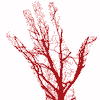
2 circulatory loops around the bodyBlood vessels includes arteries, veins and capillaries which, with the heart, forms the circulatory system. The heart pumps blood through the arteries to the capillaries, which oxygenates the cells of the body. The deoxygenated blood then returns to the heart through the veins and the cycle starts again around 1440 times a day. The total length of all blood vessels (“Vas sanguineum”) is around 100,000 km (62,137 miles).
- Transports oxygen-rich blood from the lungs to the cells and carbon dioxide-rich blood back to the heart
- Transports nutrients from digestion into the tissues
- Transports waste products to the excretory organs (kidney and intestines).